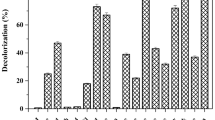Abstract
Synthetic dyes, azo dyes in particular, are widely found in the effluents from textile industries. The persistence and toxicity of these compounds cause adverse impacts in the receiving streams. A mixed culture isolated from a domestic wastewater treatment plant was found to remove the colour of the azo dye, methyl red, efficiently. Total decolorization and degradation occurred within 18 h. The mixed culture could degrade 700 mgl−1 of methyl red efficiently in the presence of 200 mgl−1 of glucose, whereas in the absence of glucose it could degrade only 100 mgl−1 of methyl red. The mixed culture, when suspended in phosphate buffer along with methyl red at 100 mgl−1 concentration could degrade methyl red efficiently within 2 h of incubation. The pH of the medium decreased continuously during degradation. After the complete removal of initial methyl red, another 100 mgl−1 was added to the culture filtrate and incubated further. The mixed microbial cultures could degrade methyl red efficiently through three cycles but further degradation was not possible as the pH of the medium decreased to 3.5.
Similar content being viewed by others
References
Carliell, C.M., Barclay, S.J., Naidoo, N. and Buckley, C.A.: 1994, Directory of Environmental Standards-Reference Materials for Residue Analysis, Ehrenstorfer Catalogue, Dr Augsburg, Germany.
Chung, K.T., Fulk, G.E. and Andrews, A.W.: 1981, 'Mutagenicity Testing of Some Commonly Used Dyes,' Applied Environmental Microbiology 42, 641-648.
ETAD: 1997, German Ban of Use of Certain Azo Compounds in Some Consumer Goods, Ecological and Toxicological Association of the Dyestuff Manufacturing Industries, Information Notice No 6 (Revised).
Hartman, C.P., Fulke, G.E. and Andrews, A.W.: 1978, 'Azoreduction of Trypan Blue to Carcinogen by a Cell Free Extract of a Human Intestinal Anaerobes,' Mutation Research 58, 125-132.
Hu, T.L.: 1994, 'Decolorization of Reactive Azo Dyes by Transformation with Pseudomonas luteola,' Bioresource Technolology 49, 47-51.
Hu, T.L.: 1998, 'Degradation of Azo Dyes RP2B by Pseudomonas Luteola,' Water Science Technology 38, 299-306.
Idaka, E., Horitusu, H. and Ogawa, T.: 1987, 'Some Properties of Azoreductase Produced by Pseudomonas Cepacia,' Bulletin of Environmental Contamination and Toxicology 39, 982-989.
Knapp, J.S. and Newby, P.S.: 1995, 'The Microbial Decolorization of an Industrial Effluent Containing Diazo Linked Chromophore,' Water Research 29, 1807-1809.
Kulla, H.G.: 1981, 'Aerobic Bacterial Degradation of Azodyes,' in T. Leisinger, A.M. Cook, J. Nuesh and R. Hutter (eds.), Microbial Degradation of Xenobiotics Recalcitrant Compounds, Academic Press, London, pp. 387-399.
Ogawa, T. and Yatome, C.: 1990, 'Biodegradation of Azo Dyes in Multistage Rotating Biological Contactor Immobilization by Assimilating Bacteria,' Bulletin of Environmental Contamination and Toxicology 44, 12-14.
Olligaard, H., Frost, L., Galster, J. and Hansen, O.C.: 1999, 'Survey of Azo Colorant in Denmark,' Miljo project, 509 Danish EPA.
Paszczynski, A., Pasti-Grigsby M.B. and Ynski, S.G.: 1992, 'Mineralization of Sulfonated Azo Dyes and Sulfanilic Acid by Ph. Chrysosporium and St. Chrofuscus,' Applied Environmental Microbiology 58, 3598-3604.
Rafi, F., Fraeankalin, W. and Cerniglia, C.E.: 1990, 'Azoreductase Activity of Anaerobic Bacteria Isolated from Human Intestinal Microfora,' Applied Environmental Microbiology 56, 2146-2151.
So, K.O., Wong, P.K. and Chang, K.Y.: 1990, Decolorization and Biodegradation of Methyl Red by Acetobacter Liquefaciens,' Toxicological Assessment 5, 221-235.
Sugiura, W., Miyashita, T., Yokoyama, T. and Arai, M.: 1999, 'Isolation of Azo Dye Degrading Microorganisms and Their Application to White Discharge Printing of Fabric,' Journal of Biosciences and Bioengineering 88, 577-581.
Wong, P.K. and Yuen, P.Y.: 1996, 'Decolorization and Biodegradation of Methyl Red by K. Pneumoniae RS13,' Water Research 30, 1736-1744.
Wuhrmann, K., Mechsner, K. and Kappeler,T.: 1980, 'Investigation on Rate Determining Factors in the Microbial Reduction of Azo Dyes,' European Journal of Applied Microbiology and Biotechnology 9, 325-338.
Zimmermann, T., Gasser, F., Kulla, H.G. and Leisinger, T.: 1984, 'Comparison of two Bacterial Azoreductases Acquired During Adaptation to Grow on Azo Dyes,' Archives of Microbiology 138, 37-43.
Zollingre, H.: 1987, Colour Chemistry-Synthesis, Properties and Application of Organic Dyes and Pigments, VCH, New York, pp. 92-102.
Author information
Authors and Affiliations
Rights and permissions
About this article
Cite this article
Vijaya, P., Sandhya, S. Decolorization and Complete Degradation of Methyl Red by a Mixed Culture. The Environmentalist 23, 145–149 (2003). https://doi.org/10.1023/A:1024839805387
Issue Date:
DOI: https://doi.org/10.1023/A:1024839805387




